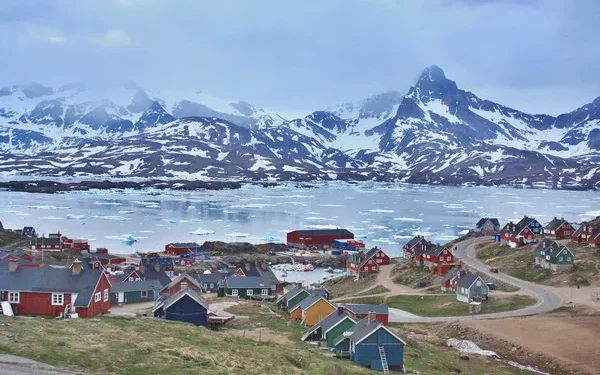Islands, with their pristine beaches, lush landscapes, and rich biodiversity, have long captured the imagination of travelers and explorers alike. From tropical paradises to rugged wildernesses, these remote landmasses offer a glimpse into the diversity and beauty of our planet. In this comprehensive guide, we embark on a journey to uncover the top 10 largest islands in the world, each boasting its own unique charm and allure.
Unveiling Top 10 World’s Largest Islands!
1. Greenland
Location: North Atlantic Ocean
Greenland reigns as the largest island in the world, spanning an expansive area of approximately 2,166,086 square kilometers. Despite its name, Greenland is largely covered by ice, with vast ice sheets dominating its landscape. Home to stunning fjords, towering glaciers, and diverse wildlife, including polar bears and whales, Greenland offers a glimpse into the raw beauty and untamed wilderness of the Arctic.
2. New Guinea
Location: Oceania
New Guinea, the second-largest island in the world, is located in the southwestern Pacific Ocean. Spanning an area of approximately 785,753 square kilometers, this island is divided between two countries: Papua New Guinea to the east and Indonesia to the west. With its dense rainforests, rugged mountains, and vibrant cultures, New Guinea is a haven for biodiversity and cultural diversity.
3. Borneo
Location: Southeast Asia
Borneo ranks as the third-largest island globally, covering an area of approximately 748,168 square kilometers. Shared by three countries – Indonesia, Malaysia, and Brunei – Borneo is renowned for its ancient rainforests, exotic wildlife, and stunning beaches. Home to endangered species such as orangutans, pygmy elephants, and proboscis monkeys, Borneo is a biodiversity hotspot of global significance.
4. Madagascar
Location: Indian Ocean
Madagascar, situated off the southeastern coast of Africa, is the fourth-largest island in the world, spanning approximately 587,041 square kilometers. Renowned for its unique flora and fauna, Madagascar is often referred to as the “eighth continent” due to its high levels of endemism. From lush rainforests to arid deserts, this island offers a diverse range of ecosystems and habitats.
5. Baffin Island
Location: Arctic Ocean
Baffin Island, located in the Canadian Arctic Archipelago, ranks as the fifth-largest island globally, covering an area of approximately 507,451 square kilometers. Characterized by its rugged landscapes, towering peaks, and vast tundra, Baffin Island offers a glimpse into the pristine wilderness of the Canadian North. Home to indigenous Inuit communities, Arctic wildlife, and ancient glaciers, Baffin Island is a remote and awe-inspiring destination.
6. Sumatra
Location: Southeast Asia
Sumatra, the sixth-largest island in the world, is situated in western Indonesia, spanning approximately 443,066 square kilometers. Renowned for its dense rainforests, active volcanoes, and diverse wildlife, Sumatra is a haven for nature enthusiasts and adventurers. From the iconic orangutans of Gunung Leuser National Park to the pristine beaches of Pulau Weh, Sumatra offers a wealth of natural wonders to explore.
7. Honshu
Location: East Asia
Honshu, the largest island in Japan, ranks as the seventh-largest island globally, covering an area of approximately 227,960 square kilometers. Home to bustling cities, ancient temples, and serene countryside, Honshu offers a fascinating blend of traditional culture and modern innovation. From the iconic skyline of Tokyo to the historic temples of Kyoto, Honshu is a vibrant and dynamic destination.
8. Victoria Island
Location: Arctic Ocean
Victoria Island, located in the Canadian Arctic Archipelago, is the eighth-largest island in the world, spanning approximately 217,291 square kilometers. Characterized by its stark beauty, vast tundra, and rugged coastlines, Victoria Island offers a remote and pristine wilderness experience. Home to indigenous Inuit communities and diverse Arctic wildlife, including polar bears and caribou, Victoria Island is a haven for adventure seekers and nature lovers.
9. Great Britain
Location: Europe
Great Britain, comprising England, Scotland, and Wales, ranks as the ninth-largest island in the world, covering an area of approximately 209,331 square kilometers. Steeped in history and culture, Great Britain offers a wealth of attractions, from iconic landmarks such as Big Ben and Stonehenge to picturesque countryside and charming villages. With its rich heritage, diverse landscapes, and vibrant cities, Great Britain remains a perennially popular destination for travelers from around the globe.
10. Ellesmere Island
Location: Arctic Ocean
Ellesmere Island, located in the Canadian Arctic Archipelago, rounds out the list as the tenth-largest island globally, spanning approximately 196,236 square kilometers. Known for its rugged terrain, polar deserts, and massive ice caps, Ellesmere Island offers a remote and pristine wilderness experience. Home to Arctic wildlife such as muskoxen, Arctic foxes, and migratory birds, Ellesmere Island is a haven for wildlife enthusiasts and adventurers seeking solitude in the far north.
See Also: 10 Biggest Volcanic Eruptions In History
Conclusion
From the icy landscapes of Greenland to the tropical rainforests of Borneo, the world’s largest islands offer a captivating blend of natural beauty, cultural diversity, and adventure. Whether you’re exploring ancient ruins in Madagascar or trekking through the Arctic wilderness of Ellesmere Island, these islands invite travelers to embark on unforgettable journeys and discover the wonders of our planet. As we continue to cherish and protect these invaluable natural treasures, may we also celebrate the spirit of exploration and discovery that defines our shared human experience.
You Might Be Interested In:



























